2021 Pivot Trail 429
Test Locations: Gunnison & Crested Butte, Colorado
Duration of Test: ~3 months
Wheels: 29” (27.5”+ compatible)
Travel: 120 mm rear / 130 or 140 mm front, depending on build
Frame Material: Carbon Fiber
Geometry: See Below
Stated Weight (size M, Frame + Fox Float DPS Shock): 5.9 lb (2.7 kg)
Measured Weight (size L, Pro XT/XTR Enduro build w/ carbon wheel upgrade): 27.94 lbs (12.67 kg)
MSRP:
- Team Frame and Crank (Frame, Fox Float DPS Factory Shock, RaceFace Next R Crank): $3,949
- Race XT: $5,899
- Race X01: $6,299
- Pro XT/XTR: $7,199
- Pro XT/XTR Enduro: $7,499 (tested)
- Pro X01: $7,699
- Pro X01 Enduro: $7,999
- Pro XT/XTR w/ Fox Live Valve: $9,299
- Team XTR: $9,499
- Team XTR Enduro: $9,799
- Pro X01 w/ Fox Live Valve: $9,799
- Team XX1 AXS: $10,999
- Team XX1 AXS Enduro: $11,299
- Team XTR w/ Fox Live Valve: $11,599
- Team XX1 AXS w/ Fox Live Valve: $13,099
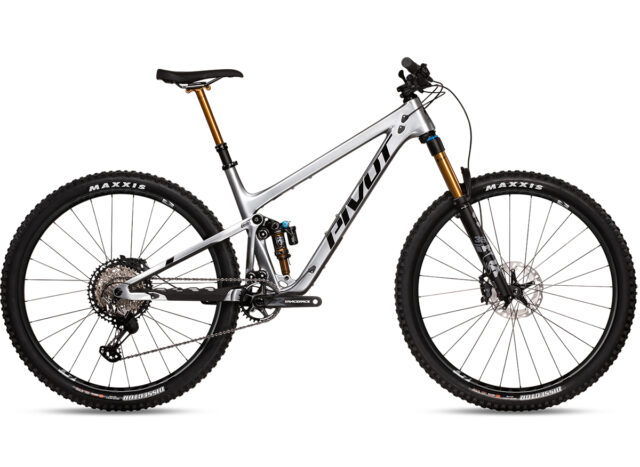
Intro
Pivot’s Trail 429 (originally known as the 429 Trail) has been a mainstay in the high-end, short-travel Trail bike market for a long time now, and Pivot recently released a new, V3 version.
The new bike gets a lot of Pivot’s new design language, with a vertically oriented rear shock and straighter lines, as well as a dose of the longer / lower / slacker treatment that we’ve come to expect from new bike releases in this day and age.
At its core, though, the Trail 429 is still a 120mm-travel, DW-Link Trail bike that’s meant to blend a lot of the efficiency of an XC race bike with a higher degree of capability when the going gets steep and rough. So how has Pivot gone about doing that, and how does it compare to both the prior version and the rest of the market?
We’ve now spent the past few months riding the Trail 429 around the Gunnison valley, so it’s time to weigh in.
The Frame
As with the outgoing version, the V3 Trail 429 is a carbon-framed, 120mm-rear-travel, DW-Link bike. Of the new version, Pivot says “this is a bike that you can shred with confidence everywhere from 24-hour race courses to untamed high alpine singletrack.” I.e., Pivot is positioning the Trail 429 as an extremely efficient bike that wouldn’t be out of place at an endurance XC race, but can also be an everyday Trail bike for a lot of riders.
The Trail 429’s overall design is in keeping with the design language Pivot has been rolling out on their latest models, including the Switchblade and Mach 6. The shock is now oriented vertically (a departure from the prior Trail 429) and the overall lines are very similar to their other, newer models. The Trail 429 is offered in five sizes, from Extra Small through Extra Large, which Pivot says covers riders from 4’11” (150 cm) to 6’7” (201 cm).
The suspension is still DW-Link, as per usual for Pivot, and features their preferred 157 mm Super Boost rear hub spacing and PF92 press-fit bottom bracket. Cable routing is all internal, with bolt-on ports to make routing simple. Pivot says that they’ve shaved 300 grams off the weight of a Medium frame, but they haven’t skimped on features.
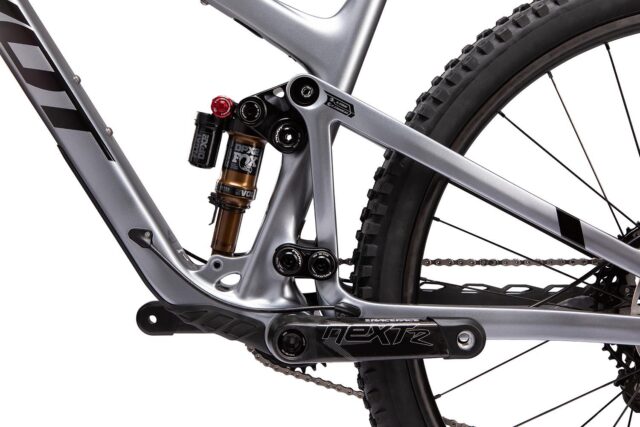
The Trail 429 gets rubber downtube, chainstay, and seatstay guards, and room for a water bottle inside the front triangle on all sizes, as well as a second set of bottle mounts underneath the downtube. A third set of mounts for a multi-tool or other accessories lives on the underside of the top tube, and ISCG ‘05 tabs are included for mounting a chain guide if desired. The rear brake mount is for a 180 mm rotor directly — no small rotors here — which, combined with the chain guide tabs, is an indicator that Pivot intends this to be much more than simply a marathon race bike.
Pivot says that the rear suspension has been made more progressive on the new model, but not by so much as to allow for a coil shock to be used — the Trail 429 is intended for air shocks only. We don’t think too many people will be bothered by that limitation for this class of bike, though there are a few options in this sort of category, including the Guerrilla Gravity Trail Pistol, that would be viable options for riders looking to run a coil shock.
The Trail 429’s tire clearance is stated at 29 x 2.6”, or 27.5 x 2.8”. Pivot notes that a 27.5 x 2.8” tire is still notably smaller-diameter than a 29 x 2.4”, and includes a 17mm-tall lower headset cup with the bike for riders who want to experiment with 27.5”+ tires, but keep the bottom bracket height up a bit. The standard zero-stack cup is meant to be run with 29” wheels, and the taller cup with 27.5”+ tires, but riders are free to mix and match as desired.
The Builds
As tends to be the case with Pivot, there are a lot of different builds on offer for the Trail 429, with many options on the higher-end of things, and few on the lower end. If you prefer to build the bike yourself, a frame with a Fox DPS Factory rear shock and RaceFace Next R carbon cranks will run you $3,949.
In short, the builds really boil down to three tiers (Race, Pro, and Team) with SRAM and Shimano options in each. The Pro and Team levels then also get options for “Enduro” versions, which swap in a Fox 36 Grip2 fork with 140 mm travel instead of the 130mm-travel Fox 34, and a Fox DPX2 for the Fox DPS rear shock. “Live Valve” versions still use a 130mm-travel Fox 34 fork and DPS shock, but in versions with Fox’s electronically controlled Live Valve dampers. The Pro builds also get the option to upgrade to Reynolds carbon wheels for a $1,300 upcharge; those are the stock wheels on Team builds.
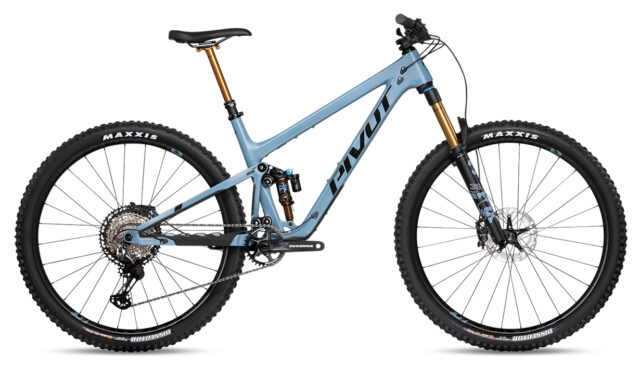
For reference, the complete build options are as follows:
- Fork: Fox 34 Performance, 130 mm travel
- Shock: Fox Float DPS Performance
- Drivetrain: Shimano SLX, w/ XT rear derailleur
- Crankset: RaceFace Ride
- Brakes: Shimano SLX M7120 4-piston, 180 mm rotors
- Wheels: DT Swiss M1900
- Dropper Post: Fox Transfer Performance Elite (XS: 100 mm; S: 125 mm; M: 150 mm; L: 175 mm; XL: 200 mm)
- Fork: Fox 34 Performance, 130 mm travel
- Shock: Fox Float DPS Performance
- Drivetrain: SRAM GX Eagle w/ X01 rear derailleur
- Crankset: SRAM Descendent 7K
- Brakes: SRAM Guide RE 4-piston, 180 mm rotors
- Wheels: DT Swiss M1900
- Dropper Post: Fox Transfer Performance Elite (XS: 100 mm; S: 125 mm; M: 150 mm; L: 175 mm; XL: 200 mm)
- Fork: Fox 34 Factory Fit4, 130 mm travel
- Shock: Fox Float DPS Factory
- Drivetrain: Shimano XT, w/ XTR rear derailleur
- Crankset: RaceFace Æffect R
- Brakes: Shimano XT M8120 4-piston
- Wheels: DT Swiss XM1700
- Industry Nine Enduro S w/ I9 1/1 hubs available for a $100 upcharge
- Reynolds Blacklabel 309/289 w/ Industry Nine Hydra hubs available for a $1,350 upcharge
- Dropper Post: Fox Transfer Factory (XS: 100 mm; S: 125 mm; M: 150 mm; L: 175 mm; XL: 200 mm)
- Fork: Fox 36 Factory Grip2, 140 mm travel
- Shock: Fox Float DPX2 Factory
- Drivetrain: Shimano XT, w/ XTR rear derailleur
- Crankset: RaceFace Æffect R
- Brakes: Shimano XT M8120 4-piston
- Wheels: DT Swiss XM1700
- Industry Nine Enduro S w/ I9 1/1 hubs available for a $100 upcharge
- Reynolds Blacklabel 309/289 w/ Industry Nine Hydra hubs available for a $1,350 upcharge (tested)
- Dropper Post: Fox Transfer Factory (XS: 100 mm; S: 125 mm; M: 150 mm; L: 175 mm; XL: 200 mm)
- Fork: Fox 34 Factory Fit4, 130 mm travel
- Shock: Fox Float DPS Factory
- Drivetrain: SRAM X01
- Crankset: SRAM X01
- Brakes: SRAM G2 RSC 4-piston
- Wheels: DT Swiss XM1700
- Industry Nine Enduro S w/ I9 1/1 hubs available for a $100 upcharge
- Reynolds Blacklabel 309/289 w/ Industry Nine Hydra hubs available for a $1,350 upcharge
- Dropper Post: Fox Transfer Factory (XS: 100 mm; S: 125 mm; M: 150 mm; L: 175 mm; XL: 200 mm)
- Fork: Fox 36 Factory Grip2, 140 mm travel
- Shock: Fox Float DPX2 Factory
- Drivetrain: SRAM X01
- Crankset: SRAM X01
- Brakes: SRAM G2 RSC 4-piston
- Wheels: DT Swiss XM1700
- Industry Nine Enduro S w/ I9 1/1 hubs available for a $100 upcharge
- Reynolds Blacklabel 309/289 w/ Industry Nine Hydra hubs available for a $1,350 upcharge
- Dropper Post: Fox Transfer Factory (XS: 100 mm; S: 125 mm; M: 150 mm; L: 175 mm; XL: 200 mm)
- Fork: Fox 34 Factory Live Valve, 130 mm travel
- Shock: Fox Live Valve Factory
- Drivetrain: Shimano XT, w/ XTR rear derailleur
- Crankset: RaceFace Æffect R
- Brakes: Shimano XT M8120 4-piston
- Wheels: DT Swiss XM1700
- Industry Nine Enduro S w/ I9 1/1 hubs available for a $100 upcharge
- Reynolds Blacklabel 309/289 w/ Industry Nine Hydra hubs available for a $1,350 upcharge
- Dropper Post: Fox Transfer Factory (XS: 100 mm; S: 125 mm; M: 150 mm; L: 175 mm; XL: 200 mm)
- Fork: Fox 34 Factory Fit4, 130 mm travel
- Shock: Fox Float DPS Factory
- Drivetrain: Shimano XTR
- Crankset: RaceFace Next R
- Brakes: Shimano XTR M9120 4-piston
- Wheels: Reynolds Blacklabel 309/289 w/ Industry Nine Hydra hubs
- Dropper Post: Fox Transfer Factory (XS: 100 mm; S: 125 mm; M: 150 mm; L: 175 mm; XL: 200 mm)
- Fork: Fox 36 Factory Grip2, 140 mm travel
- Shock: Fox Float DPX2 Factory
- Drivetrain: Shimano XTR
- Crankset: RaceFace Next R
- Brakes: Shimano XTR M9120 4-piston
- Wheels: Reynolds Blacklabel 309/289 w/ Industry Nine Hydra hubs
- Dropper Post: Fox Transfer Factory (XS: 100 mm; S: 125 mm; M: 150 mm; L: 175 mm; XL: 200 mm)
- Fork: Fox 34 Factory Live Valve, 130 mm travel
- Shock: Fox Live Valve Factory
- Drivetrain: SRAM X01
- Brakes: SRAM G2 RSC 4-piston
- Wheels: DT Swiss XM1700; Reynolds Blacklabel 309/289 w/ Industry Nine Hydra hubs available for a $1,300 upcharge
- Dropper Post: Fox Transfer Factory (XS: 100 mm; S: 125 mm; M: 150 mm; L: 175 mm; XL: 200 mm)
- Fork: Fox 34 Factory Fit4, 130 mm travel
- Shock: Fox Float DPS Factory
- Drivetrain: SRAM XX1 AXS
- Crankset: SRAM XX1
- Brakes: SRAM G2 Ultimate 4-piston
- Wheels: Reynolds Blacklabel 309/289 w/ Industry Nine Hydra hubs
- Dropper Post: RockShox Reverb AXS (XS: 100 mm; S: 125 mm; M&L: 150 mm; XL: 170 mm)
- Fork: Fox 36 Factory Grip2, 140 mm travel
- Shock: Fox Float DPX2 Factory
- Drivetrain: SRAM XX1 AXS
- Crankset: SRAM XX1
- Brakes: SRAM G2 Ultimate 4-piston
- Wheels: Reynolds Blacklabel 309/289 w/ Industry Nine Hydra hubs
- Dropper Post: RockShox Reverb AXS (XS: 100 mm; S: 125 mm; M&L: 150 mm; XL: 170 mm)
- Fork: Fox 34 Factory Live Valve, 130 mm travel
- Shock: Fox Live Valve Factory
- Drivetrain: Shimano XTR
- Crankset: RaceFace Next R
- Brakes: Shimano XTR M9120 4-piston
- Wheels: Reynolds Blacklabel 309/289 w/ Industry Nine Hydra hubs
- Dropper Post: Fox Transfer Factory (XS: 100 mm; S: 125 mm; M: 150 mm; L: 175 mm; XL: 200 mm)
- Fork: Fox 34 Factory Live Valve, 130 mm travel
- Shock: Fox Live Valve Factory
- Drivetrain: SRAM XX1 AXS
- Crankset: SRAM XX1
- Brakes: SRAM G2 Ultimate 4-piston
- Wheels: Reynolds Blacklabel 309/289 w/ Industry Nine Hydra hubs
- Dropper Post: RockShox Reverb AXS (XS: 100 mm; S: 125 mm; M&L: 150 mm; XL: 170 mm)
Fit and Geometry
The geometry of the new Trail 429 is right in line with norms for a modern, short-travel Trail bike. The Trail 429 also adds a flip-chip that, in the lower position, slackens the headtube angle by 0.5° (from 66.5° to 66.0°), lowers the bottom bracket by 7 mm, and shortens the reach by 5 mm. The lower position also lengthens the chainstays by 2 mm, to 432 mm, in all sizes. Compared to the outgoing model, its headtube angle is a notable 1.3° slacker, its seat tube angle 1.0° steeper, and its reach 10–15 mm longer, depending on size, all with the new V3 model in its lower geometry setting.
You can see the full geo chart below. The stated numbers are all for the standard builds; Pivot says that the Enduro option slackens the headtube and seat tube angles by 0.5° due to the taller fork. The bottom bracket height should also raise slightly, and the reach shorten a touch with the Enduro builds, but Pivot doesn’t state changes for those figures.
Compared to the Transition Spur, a notably progressive 120 / 120 mm travel bike, the lower geometry position for the Trail 429 is mostly quite similar. The Spur gets a slightly steeper seat tube angle and a touch longer reach and chainstays, but the changes are subtle. The biggest difference might actually be the bottom bracket height — the Spur gets 8 mm more bottom bracket drop, a substantial difference, though the Spur also comes with a 120mm-travel fork, and thus won’t sag quite as deeply as the Trail 429.
The Ibis Ripley also makes for an interesting comparison; both it and the Trail 429 are carbon fiber, DW-Link, short-travel Trail bikes, and again have quite similar geometry numbers. As with the Spur, the Ripley has a slightly steeper seat tube angle than the Trail 429, but the Ripley has the same 432 mm chainstays (when the Trail 429 is in its lower geometry position), the same 66.5° headtube angle (higher position for the Trail 429) and similar reach figures as well. The XS size on the Trail 429 is notably shorter than the smallest size offered in the Spur or Ripley (both nominally a Small) though, making it a more viable option for some shorter riders.
Overall, this seems like a sensible set of geometry choices for the way Pivot is positioning the Trail 429. Designing a bike that can both be lined up for a marathon XC race, and get an “Enduro” spec build with a Fox 36 and the like is a tall order, but Pivot has laid out a middle ground that should be quite versatile. We’re looking forward to throwing a leg over one and finding out more.
FULL REVIEW
Dylan Wood: Eric Freson and I have each spent a bunch of time on Pivot’s new Trail 429, both on the flowy desert trails of Hartman Rocks as well as the high alpine singletrack of Crested Butte, and we’ve put together our thoughts on how this short-travel 29er performs in a variety of situations and terrain.
Fit
Dylan (5’11”, 155 lbs / 180 cm, 70 kg): Upon first swinging a leg over the Trail 429 and pedalling it around the parking lot, the fit immediately felt familiar and comfortable. When climbing, the moderately long reach and relatively steep seat tube angle combined for a position that felt powerful without being uncomfortable. Additionally, the cockpit didn’t feel too stretched out or too cramped – the fit on this bike really makes sense, especially if you’ve been on a few other recent Trail bikes with modern geometry. Since I have relatively long legs for my height (5’11’’ / 180 cm), I definitely had room for a longer dropper post, but it makes sense that Pivot would stock a 175 mm dropper on the size Large so that people who are on the shorter end of the range for the size Large (like reviewer Luke Koppa, at 5’8’’ / 173 cm) could also fit on this bike out of the box.
Eric Freson (5’10”, 165 lbs / 178 cm, 74.8 kg): Just like Dylan, hopping onto the Trail 429 was a drama-free experience. Getting my cockpit setup was a matter of minutes, rather than a process of extensive tweaking, and after setting my bar height and roll I was off to the races. One of the biggest highlights surrounding fit that stood out to me was that, even on a Large frame with a fairly long reach, I didn’t need to slam the seat rails all the way forward to find the sweet spot of my preferred seating / pedalling position over the bike. It was nice to feel like I had room to experiment there, rather than starting out on the limits. I also could have used a longer dropper post, but 175 mm of drop always felt like enough for me.
Climbing
Dylan: I was quite impressed by the Trail 429 every time I pointed it uphill. First of all, it is quite light, at 27.9 lbs without pedals (Pro XT/XTR Enduro build w/ Reynolds carbon wheels). This low weight was immediately apparent when climbing, and resulted in a snappy, nimble feel. Geometry-wise, the 74.5º effective seat tube angle (“lower” geometry setting, Enduro build) was steep enough to still be able to weight the front wheel when seated on steep climbs, without being so far forward as to feel awkward on flatter or more undulating climbs.
The vertically-oriented DW-link suspension falls on the more efficient end of the spectrum. This resulted in a little less traction than bikes with a more plush feel, but it also made for a pedalling platform with very little pedal bob. I never felt inclined to touch the rear suspension lockout unless I was on a road.
Eric: The reach and stack numbers on the Trail 429, coupled with my height of 5’10’’ (178 cm) meant that I was in a pretty ideal position for out-of-the-saddle climbs attacking the trail. This is what stood out to me most about climbing on the Trail 429. It just made it easy to focus on sending energy down through the pedals rather than thinking about elbow bend or body position over the front of the bike to maintain traction. I was naturally in a neutral position out of the saddle, and not needing to focus on anything other than my breathing led to some PRs on climbs I know well.
The Trail 429 is an efficient climber in the rear shock’s “open” position. That said, flipping it to its middle “trail” mode had me attacking corners and sections of trail out of the saddle I might have otherwise been sitting and spinning on normally. I’ve put some big days on the Trail 429, and it’s an outstanding option for all-day epics. This isn’t a bike where you feel your legs being sapped of energy at every pedal stroke on a long grind of a climb, or where your back is sore from wallowy / bouncy shock compression over the course of hours. I did several 40+ mile rides where, while certainly tired by the end, I felt significantly better and fresher than I would have if I had done the same ride on a longer-travel or less-supportive bike. There are lots of factors at play here, including weight, suspension efficiency, tire choice, and fit, but they all come together to make a very mean marathon bike that feels fast everywhere, both up and down.
Descending
Dylan: I was expecting the Pivot to climb quite well, given that it was a fairy short-travel, DW-Link, lightweight 29er. These same characteristics made for a sporty, playful, and nimble feel on descents.
The Trail 429 in an Enduro build and the impressively burly Pro XT/XTR spec (more on that later) definitely descended more like a Trail bike than an XC race rig. With a relatively slack 65.5º head tube angle and 470 mm reach in a size Large, the Trail 429 felt surprisingly unfazed by high speeds and aggressive riding. Throw some rock gardens and small drops and jumps in the mix, and this bike handled it all without unpredictably bucking me. I ended up running about 30% sag in the rear shock (or right around the “Race” line on Pivot’s sag indicator tool; there’s also a “Trail” line that indicates ~34% sag), and it let me ride quite hard without bottoming out, and still provided a good amount of traction. I definitely used just about all of the travel provided on almost every ride, but it was hard for me to truly bottom out this bike (an inappropriate huck-to-flat did the trick, though).
On the slower, yet technical trails at Hartmans that feature tricky rock moves as well as steep and long rock rolls, the Pivot Trail 429 was easy to control and precise. At track-stand speeds, the 429 felt balanced and allowed me to make any adjustments before plunging into a committing line. The roomy cockpit also allowed for me to shift my weight as necessary, and let me get really far back over the pedals on those extra steep lines. The Shimano XT 4-piston brakes and Maxxis Dissector tires also provided plenty of control when I needed it most.
Now, I should mention again that the Trail 429 felt more sporty and efficient than it did plush and forgiving. There are definitely better bikes out there if you take a more passive approach through rock gardens and like to let your bike mute out most of the trail. Instead, the Trail 429 requires a dynamic style and lots of targeted weighting and unweighting for the smoothest ride through chunky sections of trail. However, this same suspension characteristic allows the Trail 429 to handle harsh g-outs and high-speed corners better than more plush bikes like the Santa Cruz Hightower. Not only this, but the supportive, sporty ride also let the 429 carry momentum better and gain speed by pumping on more mellow and flat trails.
I’d also call the Pivot Trail 429 a playful bike. It seems to want to get in the air at about any chance it has, and the responsive suspension platform really lets you push off it to get some good air time. Its relatively short chainstays also make the bike easy to manual and flick around.
As I mentioned earlier, the Trail 429’s moderate geometry mixed with its responsive suspension made it fun on mellower trails where more plush, longer bikes feel sluggish.
Eric: Dylan really captures most of what I’d like to point out about the 429 Trail. But there are a few areas I’d like to double down on and reiterate.
I also appreciated the roomy 470 mm reach when headed downhill. It was easy to use body language to compensate for less travel whenever I needed to, without feeling like I was getting too far in front or behind the bike.
I think Pivot nailed the factory compression tune on the Fox Float DPX2 shock spec’d on the Trail 429 we tested. When running ~30% sag, traction felt excellent off the top, but there was plenty of controlled ramp-up to help me deal with larger compressions and g-outs. I rode the Trail 429 everywhere, which also included time on some local “unlisted” trails with wooden features, large compressions, and even gap jumps. The Trail 429’s stiff front end (thanks to the Fox 36) and supportive rear end had me hitting everything with confidence. There’s definitely less margin for error than on a longer-travel bike, but if you hit things cleanly, the Trail 429 is impressively capable.
As Dylan points out, this is not a bike for the passive rider who is used to using lots of suspension to smooth out the trail, but rather an aggressive rider who is looking for a bike that can go fast, but requires a more active touch when things get rowdy. That type of rider is going to find a ton to like here. The Trail 429 can hang tough on high-speed trails or make you feel like you’re flying on a mellower trail where you need to work to build speed.
The Trail 429 Pro XT/XTR Enduro’s geometry, stiff chassis, aggressive build kit, and supportive suspension all work very well together. I came away very impressed by the downhill performance of the Trail 429. The frame, fork, brakes, and wheels all helped me feel confident to throw the bike into corners, features, and rock gardens with little worry. It was very enjoyable to spend time on a bike where the challenge was to ride precisely, but where you were also encouraged to stay off the brakes everywhere possible.
The Build
Dylan: We’ve been riding the Trail 429 in the Pro XT/XTR Enduro build, with the Reynolds carbon wheel upgrade. That includes a Fox Factory 36 Fork with a Grip2 damper, Fox Factory DPX2 shock, 4-piston Shimano XT brakes, stiff and smooth Reynolds Blacklabel carbon wheels, and grippy-yet-fast 2.4-inch Maxxis Dissector tires. It also means an $8,849 price tag, but as you’d hope at that price, this build left little to be desired in terms of additional upgrades to improve descending performance for a short-travel 29er. Many of those components would be equally at home on a longer-travel Trail bike, and they definitely give the Trail 429 a more aggressive personality on the descents for a short-travel bike.
Not only was I happy with the build kit when pointing the bike downhill, but the 12-speed Shimano XT/XTR drivetrain, stiff wheelset, relatively fast-rolling tires, and overall low weight of the Trail 429 made for an efficient, smooth ride uphill. Those who may want a more XC-esque ride on the uphill ought to just go with a standard build on the Trail 429, rather than an “Enduro” one. On a standard build of equivalent level, you’d get lighter suspension and 10mm less travel in the fork, as well as slightly steeper geometry to keep that front wheel even more planted (due to the fork length change). Since both levels of kits come with 2.4-inch Dissectors, though, I could see someone who (1) rides trails that aren’t very loose at all or (2) just generally doesn’t struggle with traction wanting to switch over to some faster-rolling, more XC-style tires.
As far as the wheel upgrade goes, I would recommend it to those who are more sensitive to how their wheelset affects the way their bike rides and are looking for some more precision out of their bike. I’ve never ridden Reynolds carbon wheels before, but I was very happy with the Blacklabel wheels on our Trail 429. They were smooth, precise, and stiff without being harsh or unforgiving. Add in some Industry Nine Hydra hubs with about a billion points of engagement (there’s actually “only” a staggering 690 points, or one point of engagement every 0.52°) and you’ll likely never find yourself in a “dead zone” of your hub.
Eric: Dylan says it well. There’s very little I’d change on my own custom build.
This was my first time riding Maxxis’s Dissector tire, and I’m a big fan. For the loose-over-hardpack you find so often in the Gunnison Valley, they offered excellent bite in corners, predictable release, and were very fast rolling. I’m now interested in trying the 2.6’’ width on a longer-travel bike. It is worth noting that their lifespan is quite short, and a couple months and a couple hundred miles in, they are chunking quite badly. This isn’t a tire you are going to get 600 miles of hard riding out of (all the Trail 429 builds come with 2.4″ Dissectors front and rear, Exo casing, 3C Maxterra compound).
I do think the Enduro build of the 429 Trail should be spec’d with a ~203 mm front rotor. The bike lets you run it out fast enough that there were absolutely times I could have used some more brake. Crested Butte’s trails are generally quite fast and straight, but I’m still not a huge rider and I definitely glazed some pads and boiled fluid on the 429 Trail during my time riding it.
Low BB / Lower BB Geometry Flip Chip
Dylan: Pretty standard stuff here, but I thought I’d touch on the ride differences between the two geometry settings on the Trail 429. Overall, the Low BB setting provides a more agile, climb-friendly feel. With slightly steeper seat tube and head tube angles, the Trail 429 felt a little snappier and a little more weight-forward-biased, both while climbing and descending. It also allows for a bit more bottom bracket clearance, but I don’t think this should be an issue for anyone.
The lower BB setting felt more stable at higher speeds, made the bike feel a bit easier when initiating a corner, and a little more connected with the trail. I didn’t notice many compromises in this setting, especially given that I am almost always more focused on descending than climbing. I suppose some may hit their pedals on rocks a little more in this setting, but in my mind, that is always something you can alleviate with some better timing and a little more mindfulness of where your pedals are. I don’t think there are many trails out there where a 7 mm change in BB height is going to make a dramatic difference in how often you’re hitting your cranks / pedals / chainring.
I should also note that changing the geometry between the two settings is very easy. It is something you can do at a trailhead in less than 5 minutes, and you don’t even have to remove any nuts or bolts from the frame – everything can stay intact the whole time, you simply need to loosen them enough to be able to spin them around.
Eric: It is very easy to change between the bike’s two geo settings — you should make sure you check out both! I will just leave this point here: when running the Trail 429 Enduro build in the “very low” setting, other than ~.5 degrees of seat tube angle, .5 a degree of head tube angle, and .5 in of wheelbase, the size Large Trail 429 Enduro and size Medium Pivot Firebird 29 (my personal bike) have very similar geo numbers. Being able to jump between both bikes and immediately feel at home in terms of fit, body position, and size — but with two very different types of ride characteristics — has been so, so enjoyable for me the last month. It’s been so much fun to feel “up to speed” on two very different, but very fast bikes at the same time.
Who’s It For?
Dylan: I can see a few groups of riders who could get along well with the Pivot Trail 429.
- Riders looking for an efficient, lightweight Trail bike. Mountain bikers who prioritize how well their bike climbs but still want a bike that allows them to ride fast and hard on the majority of descents will appreciate the responsive, sporty feel of the Trail 429.
- Those who like to ride for very long distances. Similar to my last point, the Trail 429 provides a nice balance of uphill efficiency and downhill forgiveness. This translates to being able to put tons of energy right into the pedals without getting beat up and fatigued on the descents, allowing for some recovery before the next big climb.
- Riders looking for a more playful, sporty, and responsive counterpart to a bigger, more sluggish bike. If you often find yourself over-biked and want to complement your Enduro or Freeride bike with a shorter-travel bike that will be more fun on mellower trails, the Trail 429 might be the ticket.
All that being said, those looking for a very efficient full-suspension bike for shorter, more climb-focused rides or races might be better off with a more purebred XC bike, like the Pivot Mach 4 SL. Also, those looking for a short-travel 29er that has plenty of traction and is more forgiving than it is responsive might be better off with the more plush options out there, like the Banshee Phantom V3. And most obviously, if you don’t mind a bike that is more sluggish on the climb as long as it is plush and forgiving on the descent, there are plenty of longer-travel trail bikes that will suit you better.
Eric: Yup… Not much to add here. The Trail 429 is an excellent option among the new breed of “fast and rowdy,” shorter-travel Trail bikes that exist today.
Bottom Line
Dylan: Those looking for a stiff, responsive, and playful Trail bike ought to add the Pivot Trail 429 to the list of bikes to check out. With an efficient pedaling platform, precise and sporty ride, and capable build kits, the Trail 429 is both versatile and fun in many situations.
Eric: The Pivot Trail 429 with the Enduro build is an ideal platform for someone who likes very high average speeds over the course of their ride — both on the ups and downs. What I found myself being drawn to most during my time with the Trail 429 was to see how fast I could complete large loops of singletrack. Big climb, big descent, higher mileage? I’ve been grabbing the 429 Trail every time. It’s addicting to be knocking huge chunks of time off loops I know well and am familiar with, and the 429 Trail definitely lets me do that.

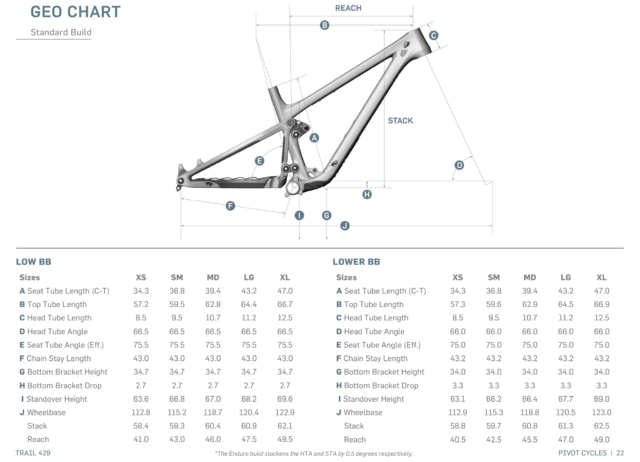
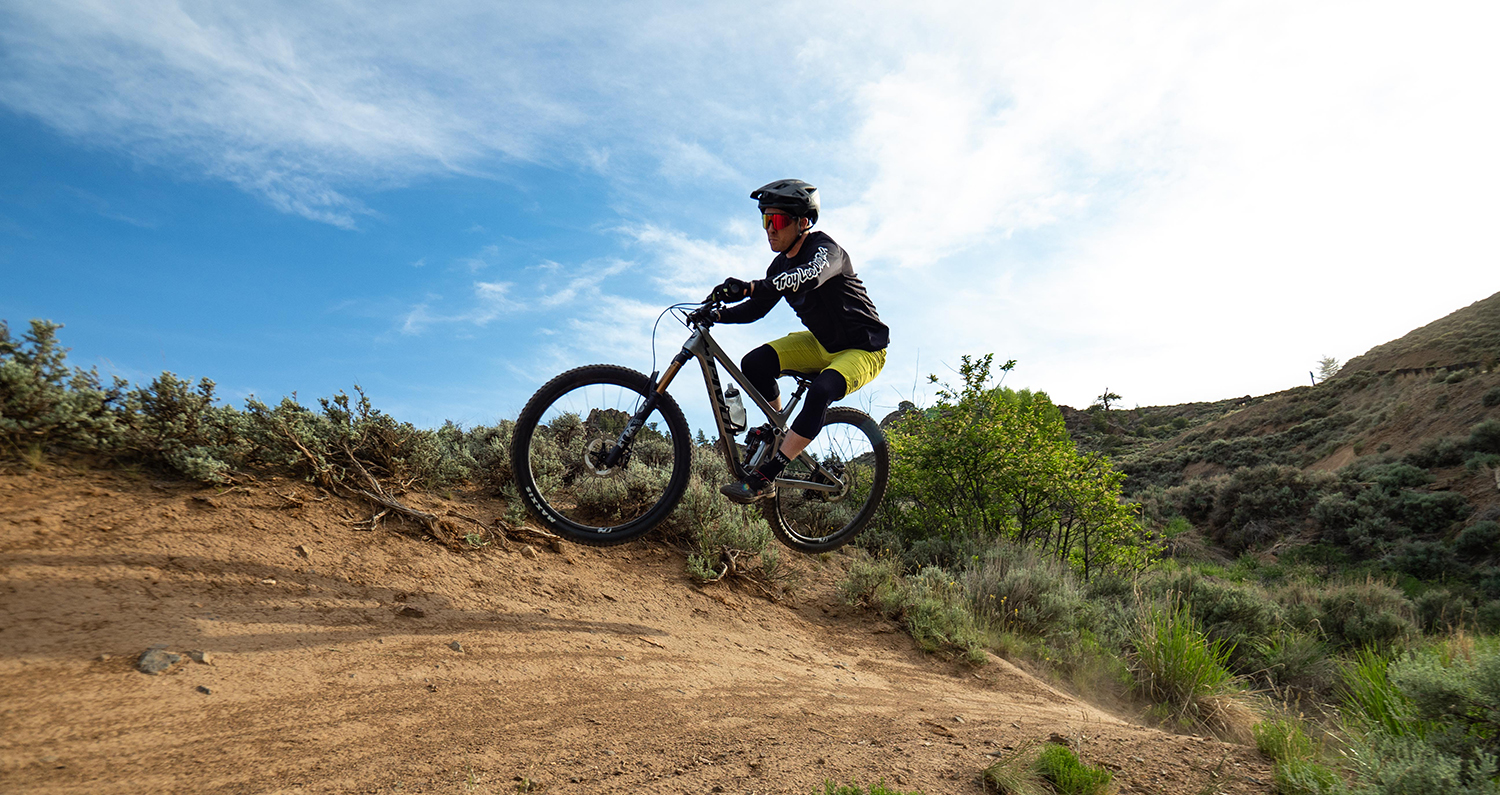
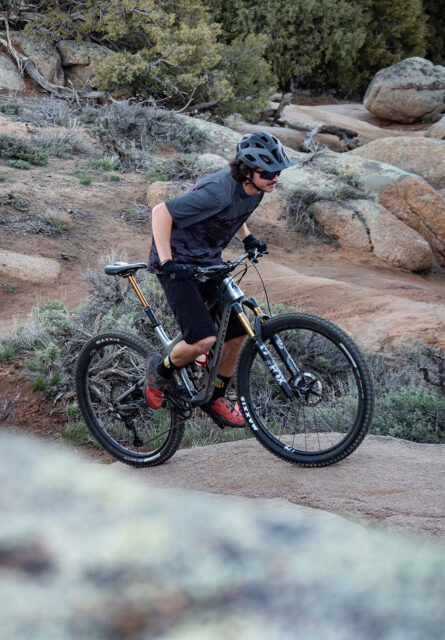
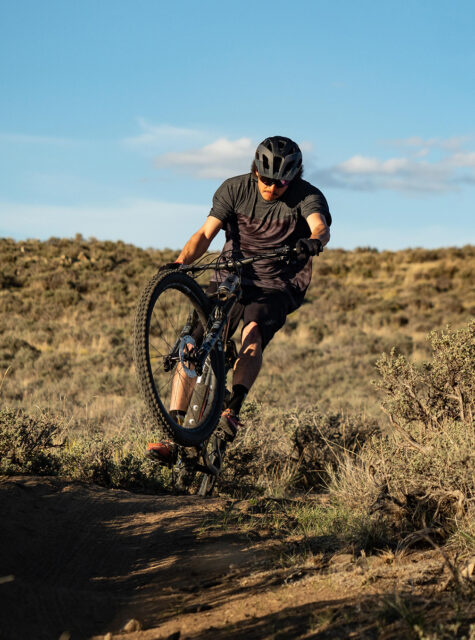
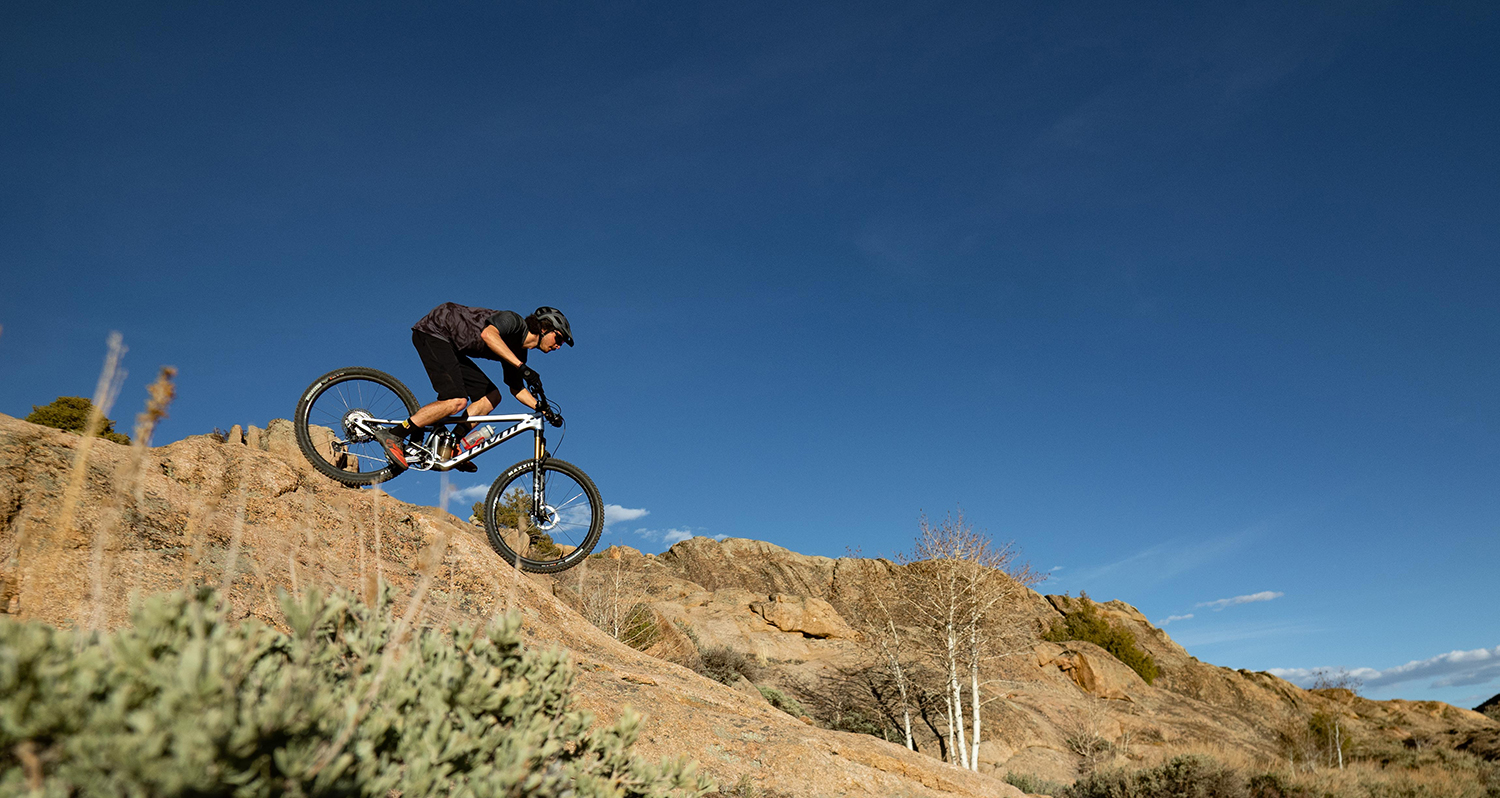
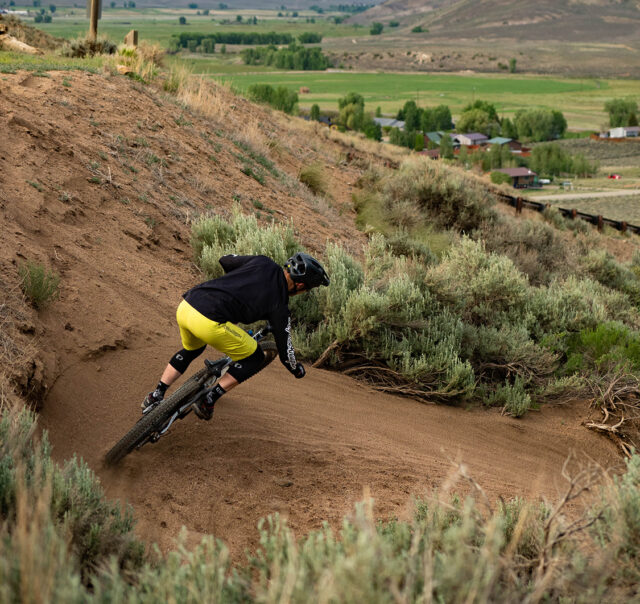
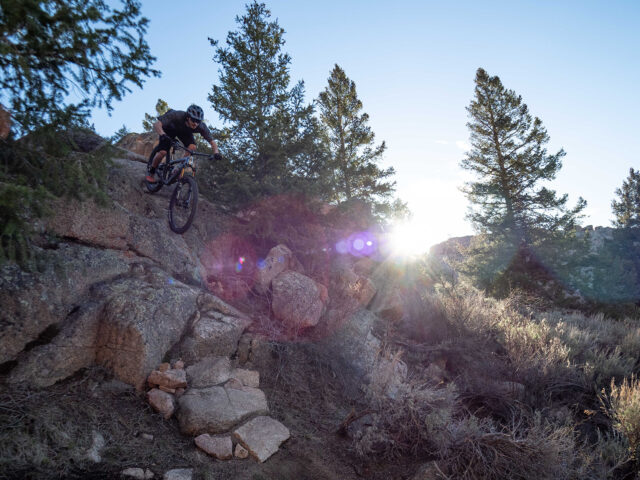
I’ve ridden about 4,900 East Coast XC/trail miles on the first version, bought in early 2016. Solid bike and frame, easy to live with, covers ground fast.
Some details over the long term to contextualize your upcoming review…
The frame is built tough and built right. No problems with PF92 BB shell, never a creak. Head tube is properly finished and sized and accepts headsets firmly, including an angleset. Easy-ish at home to replace pivot bearings, cable housing, remove or reorient the rear shock. Frame small parts were in stock and mailed to me promptly (hanger, suspension bolt). The rubber downtube and chainstay protection is effective and still firmly in place with some scars. The chainsuck protection metal plate fell off the chainstay after three years, but only needed for 2X builds because 1X doesn’t chain suck. A dozen or so paint chips score the underside of the BB shell from rock strikes, but the carbon structure is intact. Paint elsewhere looks good. (In an owner error, I caused the under-downtube bottle cage mount to be stripped out… didn’t respect the limits of those aluminum fittings, strapped a “bottle toolkit” into a cage which then acted like a slide hammer over time, fracturing the threads.) Looking to replace bike this year… considering V3 in XC kit, as well as Kona Hei Hei, Spot Ryve, Epic Evo.
-Andy
Trail 429 Race X01 for $5900 vs Ripley GX for 5400 is a tough apple to bite. Pivot gives you a nicer hub and an XO1 RD for $500 extra and the Pivot hype. Ibis gives you a carbon bar and Shimano brakes for $500 less.
Wife went with a Ripley GX with Fox Factory and Ibis S28 Carbon upgrade for $6200. I went YT Izzo Pro Race with FULL X01, Fox Factory and XMC1200 for $5400.
Hightower everyday and twice on Sunday.
How does this bike compare to the tallboy?
We haven’t ridden the Tallboy, so it’s hard to compare the two based off anything other than their geometry.
Speaking of which, their geometry is quite similar when comparing the standard (non-Enduro) Trail 429 and Tallboy. The Tallboy has slightly shorter reach and slightly longer chain stays, so it might bias your weight a little more forward than the Trail 429 and not be quite as nimble in the rear end. The Tallboy is also slightly more slack and has a steeper seat tube angle, so it might feel a little more comfortable on steep climbs and have more stable handling at higher speeds on the descent. On the “Enduro” builds, the Trail 429 becomes almost as slack in the “lower” geometry position, though the seat tube angle would be even more slack.
I think it will most come down to the differences in suspension, with the Trail 429 sporting efficient and sporty DW-link suspension, and the Tallboy featuring generally more plush VPD suspension. I’d recommend demoing both if you have the chance.
How would you compare the 429 enduro build to the switchblade that you also reviewed and what do you think the use case is for each? Seems you could make the argument that the 429E weighs almost as much as the switchblade and has very similar geo so you might as well have the extra suspension given that the switchblade is also known to be a sporty, responsive bike. What do you think? Thanks for the through reviews btw, good reading
Mitch,
The two bikes feel pretty similar overall, both in geometry and suspension design. They’re both sporty, but sporty relative to their classes. Efficient 120 mm and efficient 142 mm of suspension do feel different, with the Switchblade being a more capable bike.
The Trail 429 Enduro is a more efficient bike and a better climber overall. While they’re both impressively capable bikes, the Switchblade does a better job of smoothing out chunk and being more forgiving of harsh g-outs or flat landings. The Trail 429 Enduro is a great trail bike for those looking for something that climbs well but is efficient and still relatively capable bike. The Switchblade would be the better choice the more that downhill performance and forgiveness is a priority, and the more you shuttle or ride the bike park.
Riden the FOX FLOAT X, on the enduro yet? Comments on + and -?
I put a deposit down on the AXS ENDURO version. Thinking maybe the AXS dropper is not as good or durable as the FOX or BIKE YOKE?
Thank you.
Hmmm, I am not sure that the Fox Float X would be necessary on the Trail 429 Enduro build. Both Eric and I were more than happy with the DPX2, and I just don’t think you need a bigger rear shock.
Also, Fox doesn’t make a Float X in the size needed for the Trail 429. They might make it for OEM purposes, but I am not sure.
As for the dropper posts, I think the Rockshox Reverb AXS should be just fine. We’ve had no problems with it, but if you don’t want something electronic, it might be worth swapping it. Maybe use it for a little while, and you can always replace it.
Pivot’s site now shows the Enduro builds as coming with a Float X, though you’re right that Fox still doesn’t list that option on their site. I’m not surprised though, the Float X is supposed to be replacing the DPX2 in most current (i.e. metric) sizes, though the rollout has been a bit incremental.
I’ve just started spending time on the Float X on the new Guerrilla Gravity Trail Pistol and my early take is that the biggest difference is that small bump sensitivity has improved a lot. Full review coming in a bit, once I’ve got more time on it.
Ah, good to know. Thanks for catching that.
I’m guessing the Trail 429 Enduro in the lowest setting is probably close to the same geo as the Reg Trail 429 in the higher setting?
The fit number that seems off to me is the ETT. They are quite a bit longer than industry norms for both medium and large. Most size large bikes in the trail category have an ETT around 630 and this bike is 644. Similarly industry norms for medium are around 605 and this bike is 630. As someone who is normally a tweener between medium and large (5’9.5″) it makes sizing this bike even harder. I really like the reach of 470 (a bit shorter than average for a size large) but the slack seat tube makes for a really long ETT. Seems like the ETT would force me to the medium and shorter than desired reach. But none of the reviewers mentioned the funky ETT lengths. Can you comment on that at all?
I have the same question as I am the same height… I can’t imagine choosing between a large without putting significant miles on both… I.e., I’d probably have to take a trip to the factory and then he cost of that on top of the bike… argh
Anything you 429 owners have learned now that you have ridden them a little?
Enduro model vs non?
Float X qualities? Any setup or maintenance problems?
Fox 36 rock solid and great performers?
Suspension pivot points and bearings, work well so far? Or wear too fast?
Thoughts on the carbon bars and stem? Are the bars too stiff? Ergonomics?
Thoughts on the Reynolds/Hayes with Industry 9 hubs,BLACKLABEL wheels?
Anything you would change?
How long is it taking you to get the bike?
Thank you.
I recently got the trail 429 Enduro SRAM X01 build with the Reynolds black label wheels and I9 Hydra. I love it! I have a trek remedy 29 from 2016 now also. The Pivot Trail 429 just feels so much more efficient, poppy and playful! , It doesn’t beat the snot out of me like a Hardtail would or other bikes may. The 36 Grip 2 fork seems to make a huge improvement over the 36 Fit 4. Also I am loving the float X shock so far. The wheels do not seem harsh or overly stiff either. I was riding KOVEE XXX with 2.6 inch tires on the front and the Wolf Tooth Fatty grips which are great, they are thick foam type, very shock absorbing comfortable grips on my 2016 Trek remedy 29.
My new T429 comes with a 2.4 tires upfront and very thin grips (with very little shock absorbing or dispersion abilities) and the bike still feels better than my previous.
There is nothing I do not like about the T429 vs the other!
Also I had Shimano 12 speed drive train on my old bike and never liked it, it took way too much force to shift on longer rides.
The SRAM X01 is SUPER SMOOTH!
Love everything about the X01!!!
I’ve got to ask, how does this compare to the rascal? I haven’t been able to ride a 429, but, felt the rascal to be more traction oriented then efficient on the way up, and wandering front end. But, coming down was blown away with how fun the bike was. Poppy but also sucked everything up.